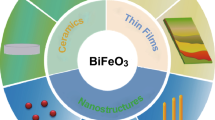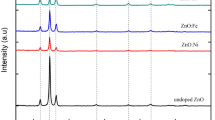Abstract
The magneto-structural (MS) and magneto-electronic (ME) effects, as well as their coupling relationship, were investigated in electroless-plated (EL) Co0.5Ni0.5 arrays treated by post N2 annealing and in situ field plating. Separately and combined, these two treatments have been widely employed to improve the properties of magnetic nanostructures. This work aimed to discriminate between treatments with respect to electronic and structural properties, and magnetic degrees of freedom of Co0.5Ni0.5 nanostructures. The field-plated sample exhibited a strong MS–ME coupling due to magneto-crystalline anisotropy (MCA), arising from a FCC (111) preferred orientation with lattice planes stacking orthogonally to the long axial direction of the arrays. A large coercivity was observed in this structure, arising from high magnetic stability. X-ray magnetic circular dichroism revealed that magnetization was enhanced primarily by Co magnetism, while the field-plated sample underwent a MS/ME transition with corresponding increase of the plating field. Conversely, the heat-treated sample comprised isotropically oriented nanocrystals approximately 20 ± 3 nm in diameter, coated with an oxidation layer (approximately 5 ± 2 nm thick). The absence of MCA in these samples ensured a weak MS–ME coupling. Although the Ni magnetization of heat-treated samples remained close to that of the field-plated sample, the Co constituent exhibited CoO and Co3O4 phases in addition to the metallic state. By contrast, the Co constituent of the field-plated sample was mainly metallic. The lack of MCA, combined with a complex Co magnetic state, appears responsible for the divergent macroscopic magnetic behaviors of the heat-treated and the field-plated samples. By isolating changes in local magnetic moments of Ni and Co, we gained a fundamental understanding of the effects of post-N2 annealing and field plating on CoNi. Such knowledge may assist researches in improving the magnetic properties of bimetallic nanostructures.










Similar content being viewed by others
References
Blanchard PE, Grosvenor AP, Cavell RG, Mar A (2008) X-ray photoelectron and absorption spectroscopy of metal-rich phosphides M2P and M3P (M = Cr-Ni). Chem Mater 20:7081–7088
Chen CT, Sette F, Ma Y, Modesti S (1990) Soft-X-ray magnetic circular dichroism at the L2, 3 edges of nickel. Phys Rev B 42:7262–7265
Chen CT, Idzerda YU, Lin HJ, Smith NV, Meigs F, Chaban E, Ho GH, Pellegrin E, Sette F (1995) Experimental confirmation of the X-ray magnetic circular dichroism sum rules for iron and cobalt. Phys Rev Lett 75:152–155
Gálvez N, Valero E, Ceolin M, Trasobares S, López-Haro M, Calvino JJ, Domínguez-Vera JM (2010) A bioinspired approach to the synthesis of bimetallic CoNi nanoparticles. Inorg Chem 49:1705–1711
Glaubitz B, Buschhorn S, Brüssing F, Abrudan R, Zabel H (2011) Development of magnetic moments in Fe1−x Ni x -alloys. J Phys 23:254210
Golosovsky IV, Mirebeau I, André G, Tovar M, Tobbens DM, Kurdyukov DA, Kumzerov YA (2006) Magnetic phase transition in a nanostructured antiferromagnet CoO embedded in porous glass. Phys Solid State 48:2130–2133
Gómez E, Pané S, Vallés E (2005) Magnetic composites CoNi–barium ferrite prepared by electrodeposition. Electrochem Commun 7:1225–1231
Hsu HC, Lo CC, Tseng YC (2012) Competing magnetic interactions and interfacial frozen-spins in Ni–NiO core–shell nano-rods. J Appl Phys 111:063919
Huang CC, Lo CC, Tseng YC, Liu CM, Chen C (2011) Magnetostructural phase transition in electroless-plated Ni nanoarrays. J Appl Phys 109:113905
Imperia P, Schmitz D, Maletta H, Sobal NS, Giersig M (2005) Effect of Ar+ and H+ etching on the magnetic properties of Co/CoO core–shell nanoparticles. Phys Rev B 72:014448
Ito N, Michels A, Kohlbrecher J, Garitaonandia JS, Suzuki K, Cashion JD (2007) Effect of magnetic field annealing on the soft magnetic properties of nanocrystalline materials. J Magn Magn Mater 316:458–461
Jiménez-Villacorta F, Prieto C, Huttel Y, Telling ND, van der Laan G (2011) X-ray magnetic circular dichroism study of the blocking process in nanostructurediron-iron oxide core–shell systems. Phys Rev B 84:172404
Kuepper K, Benoit DM, Wiedwald U, Mögele F, Meyering A, Neumann M, Kappler JP, Joly L, Weidle S, Rieger B, Ziemann P (2011) Precise chemical, electronic, and magnetic structure of binuclear complexes studied by means of X-ray spectroscopies and theoretical methods. J Phys Chem C 115:25030–25039
Kumah DP, Cebollada A, Clavero C, García-Martín JM, Skuza JR, Lukaszew RA, Clarke R (2007) Optimizing the planar structure of (111) Au/Co/Au trilayers. J Phys D 40:2699–2704
Lee YJ, de Jong MP, Jansen R (2010) Magnetism and heterogeneity of Co in anatase Co:TiO2 magnetic semiconductor. Appl Phys Lett 96:082506
Liot F, Abrikosov IA (2009) Local magnetovolume effects in Fe65Ni35 alloys. Phys Rev B 79:014202
Liu CM, Tseng YC, Chen C, Hsu MC, Chao TY, Cheng YT (2009) Superparamagnetic and ferromagnetic Ni nanorod arrays fabricated on Si substrates using electroless deposition. Nanotechnology 20:415703
Lo CC, Huang CC, Liu CM, Chen C, Kuo CY, Lin HJ, Tseng YC (2011) Magnetic properties of electroless-deposited Ni and Ni–NiO core–shell nano-arrays. J Magn Magn Mater 323:1950–1953
Mandal S, Banerjee S, Menon KSR (2009) Core–shell model of the vacancy concentration and magnetic behavior for antiferromagnetic nanoparticle. Phys Rev B 80:214420
Marín P, López M, Vlad A, Hernando A, Ruiz-González ML, González-Calbet JM (2006) Magnetic field driving custom assembly in (FeCo) nanocrystals. Appl Phys Lett 89:033508
Mousavand T, Naka T, Sato K, Ohara S, Umetsu M, Takami S, Nakane T, Matsushita A, Adschiri T (2009) Crystal size and magnetic field effects in Co3O4 antiferromagnetic nanocrystals. Phys Rev B 79:144411
Mulders AM, Loosvelt H, Fraile Rodríguez A, Popova E, Konishi T, Temst K, Karis O, Arvanitis D, Van Haesendonck C (2009) On the interface magnetism of thin oxidized Co films: orbital and spin moments. J Phys 21:124211
Niu H, Chen Q, Ning M, Jia Y, Wang X (2004) Synthesis and one-dimensional self-assembly of acicular nickel nanocrystallites under magnetic fields. J Phys Chem B 108:3996–3999
Ohtake M, Nukaga Y, Sato Y, Kirino F, Futamoto M (2009) Epitaxial growth of fcc-Co x Ni100−x thin films on MgO(110) single-crystal substrates. J Appl Phys 106:123921
Pané S, Gómez E, García-Amorós J, Velasco D, Vallés E (2007) First stages of barium ferrite microparticles entrapment in the electrodeposition of CoNi films. J Electroanal Chem 604:41–47
Press MR, Khanna SN, Jena P (1987) Electronic structure, magnetic behavior, and stability of Ni-P. Phys Rev B 36:5446–5453
Qin DH, Wang CW, Sun QY, Li HL (2002) The effects of annealing on the structure and magnetic properties of CoNi patterned nanowire arrays. Appl Phys A 74:761–765
Sankara N, Selvakumar S, Stephen A (2003) Electroless Ni–Co–P ternary alloy deposits: preparation and characteristics. Surf Coat Technol 172:298–307
Shamaila S, Sharif R, Chen JY, Liu HR, Han XF (2009) Magnetic field annealing dependent magnetic properties of Co90Pt10 nanowire arrays. J Magn Magn Mater 321:3984–3989
Singh AP, Kumar R, Thakur P, Brookes NB, Chae KH, Choi WK (2009) NEXAFS and XMCD studies of single-phase Co doped ZnO thin films. J Phys 21:185005
Spaldin N (2003) Magnetic materials: fundamentals and device applications, Chap 10. Cambridge University Press, Cambridge, p 124
Tang XT, Wang GC, Shima M (2007) Magnetic layer thickness dependence of magnetization reversal in electrodeposited CoNi/Cu multilayer nanowires. J Magn Magn Mater 309:188–196
Ung D, Viau C, Ricolleau C, Warmont F, Gredin P, Fiévet F (2005) CoNi nanowires synthesized by heterogeneous nucleation in liquid polyol. Adv Mater 17:338–344
Wu M, Liu G, Li M, Dai P, Ma Y, Zhang L (2010) Magnetic field-assisted solvothermal assembly of one-dimensional nanostructures of Ni–Co alloy nanoparticles. J Alloy Compd 491:689–693
Yamauchi Y, Yokoshima T, Momma T, Osaka T, Kuroda K (2004) Fabrication of magnetic mesostructured nickel–cobalt alloys from lyotropic liquid crystalline media by electroless deposition. J Mater Chem 14:2935–2940
Yang CY, Huang CC, Tseng YC, Liu CM, Chen C, Lin HJ (2011) Coupled microstructural and magnetic transition in Co-doped Ni nanoarrays. J Appl Phys 110:073913
Acknowledgments
The authors appreciate the great help of TEM analyses from Mr. Cheng-Yu Hsieh. This work is supported by the National Science Council of Taiwan, under Grant No. NSC 98-2112-M-009 022-MY3.
Author information
Authors and Affiliations
Corresponding author
Rights and permissions
About this article
Cite this article
Yang, CY., Tseng, YC. & Lin, HJ. Element-specific study of the coupled magneto-structural and magneto-electronic properties of CoNi nanoarrays. J Nanopart Res 15, 1542 (2013). https://doi.org/10.1007/s11051-013-1542-4
Received:
Accepted:
Published:
DOI: https://doi.org/10.1007/s11051-013-1542-4




